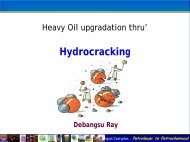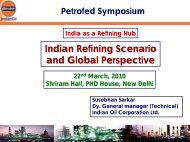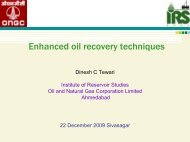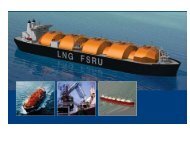Chapter -1 final last new font final - petrofed.winwinho...
Chapter -1 final last new font final - petrofed.winwinho...
Chapter -1 final last new font final - petrofed.winwinho...
You also want an ePaper? Increase the reach of your titles
YUMPU automatically turns print PDFs into web optimized ePapers that Google loves.
Bob MacKnight<br />
Lead Analyst, PFC Energy<br />
Non-OPEC Decline Rates<br />
Accelerate<br />
9<br />
www.<strong>petrofed</strong>.org<br />
declining at a global average rate of 9.4% a year<br />
(6.58% including the FSU).<br />
In other words, not only were higher oil prices<br />
unable to arrest the drop in production, but the<br />
decline rates actually accelerated in recent years.<br />
The cumulative impact is that base oil production<br />
outside OPEC and the FSU (for fields online before<br />
2000) had declined by 40% between 2000 and<br />
2008. New supply, therefore, was merely<br />
offsetting drops in base production with most of<br />
Decline rates in non-OPEC countries have risen that offset coming from production rises in the FSU<br />
since 2002, despite the investment imperative of a – and even then, as decline rates kept rising, <strong>new</strong><br />
high price environment. By 2008, non-OPEC source was unable to offset declines leading to<br />
fields outside the FSU which were producing in negative production growth.<br />
2000 were declining at an average rate of 9.4% a<br />
year. The rate would be 6.6% if the FSU were<br />
Regional trends in decline rates<br />
included. The decline rate has been increasing<br />
steadily in the past five years, evidence of the • Europe shows the largest decline rates in the<br />
industry's inability to arrest decline in mature non-OPEC world, primarily as the result of the<br />
fields. Regional variations, however, are maturity of North Sea oil production. By<br />
important. In Europe decline rates for mature 2008, the decline rate for fields producing oil<br />
fields are in excess of 30%; in Asia Pacific rates are<br />
as low as 4%. And just as high oil prices were<br />
unable to reverse decline rates, it is unlikely that<br />
low oil prices will accelerate them: aggregate<br />
decline rates are driven by resource depletion.<br />
in 2000 was over 30%, double the decline rate<br />
in 2007. In fact, base production from these<br />
older fields in 2008 was just 32% of what it<br />
was in 2000 – a loss of approximately 3.5<br />
million b/d.<br />
Decline rates accelerate all over the non-<br />
OPEC world<br />
Decline rates in non-OPEC and non-FSU supply<br />
have risen steadily in recent years, despite high oil<br />
prices: fields that were online in 2000 have been<br />
declining at an average global rate of 6.2% a year<br />
in the period from 2000 to 2008. Even that<br />
number aggregates lower decline rates in 2000-<br />
2003 with rising decline rates thereafter. By<br />
2008, fields in non-OPEC countries and outside<br />
the FSU that were in production in 2000 were<br />
• Non-OPEC Middle East and North Africa<br />
(MENA) follows with decline rates for older<br />
fields in 2008 being 9%. By 2008, non-OPEC<br />
MENA fields were producing 40% less than in<br />
2000 reflecting across the board declines in<br />
Egypt, Syria, Oman, Tunisia, Yemen and<br />
Bahrain.<br />
• In non-OPEC West Africa decline rates were<br />
6.6% in 2008 with drops coming from Gabon,<br />
Congo and Cameroon. In total, the region's

















